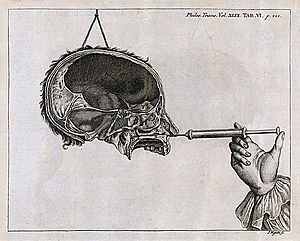Jonathan Wathen facts for kids
Jonathan Wathen (born around 1728, died 1808) was an English surgeon. He lived in London during the Georgian era. He was an expert in eye diseases. He also taught and guided other important eye doctors. These included James Ware and Sir Jonathan Wathen Waller, who was the eye doctor for King George III.
Contents
A Life in Medicine
Jonathan Wathen was born in 1727 or 1728. He likely grew up in Stroud, Gloucestershire. His father, also named Jonathan Wathen, was a rich cloth maker.
Learning to Be a Doctor
Around 1745, Jonathan began training with his older brother, Samuel Wathen. Samuel was a famous physician (a doctor who treats illnesses with medicine) in London. Samuel's patients included important people like Rev. John Wesley and Queen Charlotte.
Jonathan worked with his brother for over ten years. He probably became a partner in Samuel's practice. In 1751, Samuel's office was in Devonshire Square, London. By 1755, Jonathan was also listed at the same address. They also worked together at the City of London Lying-in Hospital. Later, they practiced at the Magdalen Hospital too.
Sharing New Ideas
In 1755, Jonathan shared a paper with the Royal Society. This paper described a way to help people hear better. He used a special tube to clear a blocked eustachian tube (a canal from the nose to the ear). Even though he presented his work, he was not made a Fellow of the Royal Society. However, he was chosen as a Fellow for the Society of Antiquaries of London. This group studies history and old things.
Eventually, Jonathan and Samuel started their own separate practices. Jonathan moved his practice to Bond-court in Walbrook, London. Samuel moved to Great Cumberland Street in St. Marylebone. Jonathan continued his work at the hospitals along with his private practice.
Family Life
Jonathan married Anne Waller on June 8, 1761. Anne was a widow with a daughter named Mary Allen. Jonathan never had his own children. In 1764, Mary Allen married Joshua Phipps. Jonathan Wathen signed as a witness. He was often called the grandfather of Mary's son, Jonathan Wathen Phipps. But he was actually his step-grandfather.
An Expert in Eye Care
Jonathan Wathen never went to a formal medical school. But he became very well known for his work. He always called himself a surgeon (a doctor who performs operations). He focused on diseases of the eye and throat. Some people even call him one of the first eye doctors in England.
However, the term "founding father of ophthalmology" (the study of eyes) might be better for James Ware. James Ware was a college-trained physician. Jonathan took James on as an assistant in 1777. The next year, they became official partners. James Ware owned a quarter of the practice. Their partnership lasted until 1791. Then, James Ware started his own practice.
James Ware became more famous than Jonathan Wathen. He was even made a Fellow of the Royal Society. But James Ware always wrote about how much he learned from Jonathan Wathen. He thanked his mentor and former partner.
Later Years
When Wathen and Ware stopped working together, Jonathan took on his step-grandson, Jonathan Wathen Phipps. This was in 1791. The younger Jonathan later became the eye doctor for King George III in 1795.
The elder Jonathan Wathen continued to practice medicine. He became as famous as his brother Samuel, who had passed away in 1787. Jonathan Wathen died on January 17, 1808. He was in East Acton, London, and was about 80 years old.
Publications
Here are some of the papers and books Jonathan Wathen wrote:
- "A Method Proposed to Restore Hearing when Injured from an Obstruction of the Tuba Eustachiana" (1756). This paper was about his method to help hearing.
- Boerhaave's Academical lectures on the lues venerea... Translated from the Latin, with notes, by Jonathan Wathen, surgeon, (1763). This was a translation of medical lectures with his own notes.
- A dissertation on the theory and cure of the cataract... (1785). This book discussed how to treat cataracts, a common eye problem.
- A new and easy method of curing the fistula lacrymalis... (1792). This book described a new way to treat a condition that causes watery eyes. It also talked about dry eyes and how to care for patients after eye surgery.


